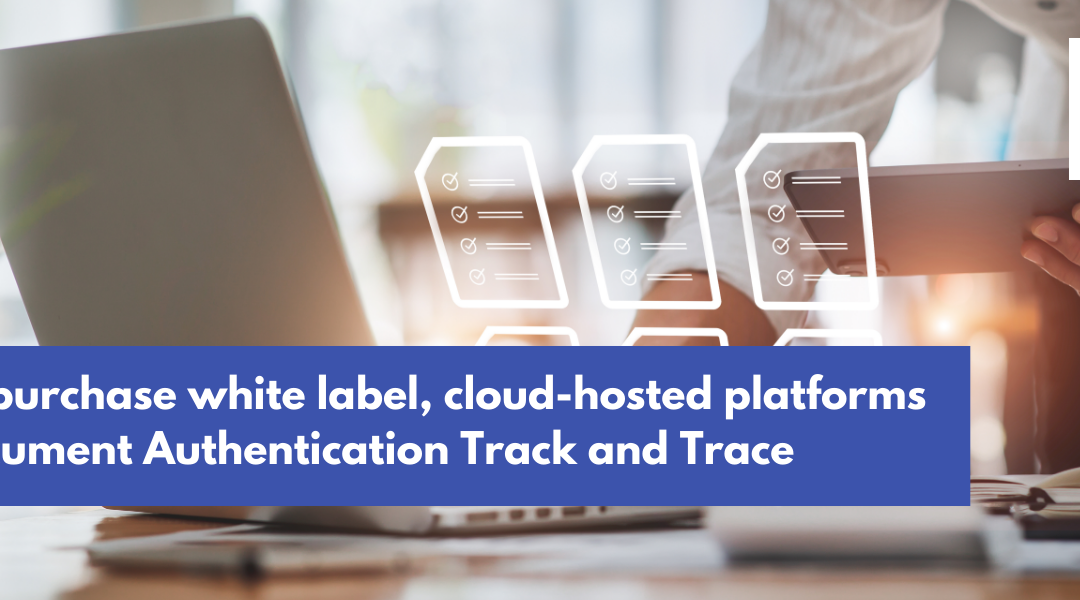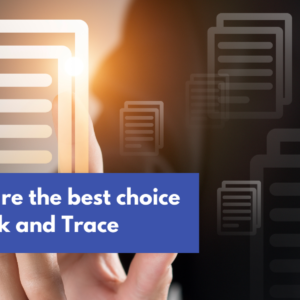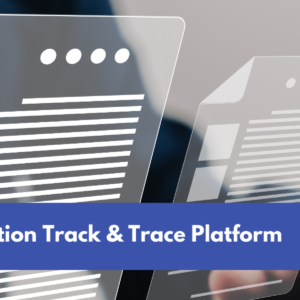This is the second blog post for NanoMatriX’s White-Label Product and Document Authentication Track-and-Trace Platform Series.
Many businesses offer white-label solutions, and many others succeed by employing white-label solutions. Expedia offers a white-label travel booking solution to businesses while Matomo implemented a white-label analytics tool and observed increased revenue by 40%.
Despite these benefits, businesses are often confused about what their business plan should be if they use a white-label solution, although it is necessary for selling a track-and-trace platform without development, deployment, or maintenance.
This confusion is understandable because if the white-label providers develop a track-and-trace platform, what will be their role in access and user management? To answer this and similar questions, this guide serves as a valuable partner for businesses wanting to develop a secure and successful business plan for white-label products and document authentication track-and-trace platforms.
When Should Businesses Consider White-Label Track & Trace Solution?
1. Businesses Want to Scale Their Services for Clients
To solve most of your clients’ business problems without spending a lot of money and investing time, you can employ white-label solutions.
2. Businesses Want to Enter the Market with a Unique Product
White-label solutions are highly customizable, and if you want to enter a market quickly without experiencing market saturation, you can employ a white-label solution and add some of your unique features to it.
3. Businesses Want to Expand their Client Portfolio
Big clients prefer a solution that solves all of their problems related to one specific area. To attract industry leaders and make them your clients, you need a product with a USP. One specific solution to getting big clients is employing a white-label solution and customizing it with your brand identity and your business’s unique features.
A Step-by-Step Guide to Develop a Business Strategy with White-Label Product and Document Authentication Track & Trace Platform
If you have decided to sell your clients a white-label product and document authentication track & trace platform, you should implement the following processes for efficient workflows:
1. Decide The White-Label Service Provider
The first step is to choose a responsible white-label solution provider. Some factors that should help you decide between a white-label service provider are as follows:
- Maintenance and Support: The service provider ensures ongoing support and maintenance for the white-label solution.
- Data Storage Flexibility: The platform allows data storage in the end-user’s country for compliance.
- Unauthorized Access Prevention: The service provider implements measures like data-label classification and strict server processes.
- Cybersecurity Assurance: The provider conducts frequent cybersecurity assessments for robust protection of the track-and-trace platform.
- Flexible Pricing: The provider offers various pricing models to suit different business needs.
- Compliance Protocols: The provider adheres to strict data protection regulations for platform compliance.
2. Understand The White-Label Service Provider’s Access Protocol Process
You should try to understand what is the standard process of the white-label service providers to make a white-label solution for you. This is because developers and other IT professionals may know the code and it might be compromised if no protocols are employed.
To combat this, consider if the white-label service provider follows these strict protocols, that NanoMatriX follows for its white-label track-and-trace platform:
- Developer Access Control: White-label solution developers are granted access to source code repositories and development environments exclusively for writing, testing, and debugging code. This access is facilitated through robust Identity Access Management (IAM) systems so only authorized personnel can perform tasks that they are assigned to and can only view data that they are permitted to view. Additionally, developers are provided with documentation and support channels to streamline their development processes.
- Deployment Pipeline Access Control: The deployment pipeline, is a critical aspect to ensure that only well-tested and bug-free code will be launched onto the production server where customers are using the track and trace platform. Here best practices should be applied whereby new software features are developed in three stages.
-
-
- Developer Environment – New Code/Feature is developed on a controlled and monitored local computer that can only be accessed by a named developer. After testing the functionality and code review, the developer pushes the code to a secured cloud-hosted server using a CI/CD pipeline, called the Staging Server.
- Staging Server – On this server the quality assurance (QA) team will test the new features/fixes for all possible scenarios, identify issues, and request the developer to fix all discovered issues on their local environment and then push the corrections to the staging server. Then Automation QA will run automated test suites so that the features meet the predefined quality standard before the code is deployed to the Production Server using the CI/CD pipeline by a Release Manager or Release Lead.
- Production Server – Access to this server is to limited persons on the team often called “Release Manager” or “Release Lead”. The production server hosts the application code used by the track & trace platform users.
-
- Local Testing Server Access Control: Developers leverage local testing through monitored dedicated desktops, and isolated environments on their machines or local networks, to validate code changes before integration into shared development environments. Access to these monitored dedicated desktops is regulated through strict authentication and user authorization mechanisms.
- Staging Server Access Control: Access to staging servers, utilized for pre-production testing and identifying software issues, is limited to authorized developers. Role-based access control (RBAC) mechanisms are implemented to enforce permission-based role and access management, granting developers the necessary privileges to test and rectify code issues while maintaining the integrity of the staging environment.
- Isolation of Production Server: Developers are explicitly prohibited from accessing the production server only the “Release Manager” or “Release Lead” has access to the environment where the finalized, public-facing version of the application operates. This isolation is enforced through stringent access control policies and robust authentication mechanisms, safeguarding the production environment from unauthorized access or modifications.
- Data Encryption and Privacy: To ensure the confidentiality and integrity of sensitive data, such as customer information and transaction records, data encryption techniques are employed. By encrypting data at rest and in transit, the white-label service provider enhances security measures and mitigates the risk of unauthorized access or data breaches.
- Isolated Database: Sensitive data is stored in an isolated database environment, separate from other components of the system. This ensures that customer information remains segregated and protected from unauthorized access or tampering. Access to the database is strictly controlled through authentication and access control mechanisms, further enhancing data security measures.
- Principle of Least Privilege: Access to data and systems is governed by the principle of least privilege, wherein individuals, including developers, IT professionals, and stakeholders, are granted access only to resources essential for fulfilling their job responsibilities. This principle is enforced through granular access controls, segregation of duties, identity and access management (IAM) solutions, and continuous compliance checks, minimizing the risk of unauthorized access and potential security breaches.
- Architectural Separation and Role Segregation: This track-and-trace platform employs architectural separation techniques to segregate customer data from the source code. This architectural design, coupled with robust access control mechanisms, enhances data security and protects sensitive customer information. Additionally, role segregation ensures that access to critical components of the platform is restricted based on predefined roles and responsibilities, minimizing the risk of data exposure or unauthorized access.
- Documented Software Support: This white-label service provider maintains comprehensive documentation of all instances where IT professionals access the code for software support or issue resolution. This documentation serves as a vital component for compliance checks and audit trails, providing evidence in the event of security incidents or legal proceedings. Additionally, access logs and audit trails are routinely monitored and reviewed to ensure adherence to security policies and regulatory requirements.
- Strong Privacy Policies: The white-label track-and-trace provider should have a strong privacy policy where they don’t have access to the system integrators’ or their customers’ data. The system integrators also don’t have access to their customer’s data. This separation of data access protocols ensures that the end customers’ data is strictly protected using data-privacy protection protocols and no one other than the customer can access their data.
- Independent Storage and Servers: Each organization, project, or customer of a system integrator should have independent storage, ensuring that their data cannot be accessed by anyone else except for that specific customer, with the system integrator and white-label solution provider backend operations adhering to strict privacy principles. The track-and-trace platform also provides independent, segregated servers to end customers on request.
Through this access management process, you can ensure the security of the white-label track-and-trace solution you’re purchasing. This helps prevent unauthorized access and protects the integrity of the solution, keeping data safe and maintaining trust with users.
3. Provide Your Requirements for the White-Label Track-and-Trace Platform:
The next step to getting a white-label product and document authentication track-and-trace platform is to articulate your needs and the features needed. Of course, there will be the basic version of the track-and-trace platform, which should include the following service offerings:
- Product authentication solution
- Document Management and Security system
- Logistics & e-Logistics Management System
- Item level tracking solution
- Retail management system
- Inventory management solution
- Warehouse management solution
- AI-powered Consumer behavior analysis and reporting system
- AI-powered geolocation tracking system
- AI-powered fraud detection system
- Product management and landing management systems
- End customer authentication system
- Order management system
- User permission management system
Apart from these service offerings, if you need anything specific or unique, you should communicate it to the white-label service providers. Some of the platform specifications you could ask the white-label service providers to add are:
- Complying with a country’s specific data-privacy protection regulations
- Adding a cold chain supply management systems
4. Test the Final Track-and-Trace Platform
After the white-label service providers develop a track-and-trace platform per your needs, you should test the platform in the following ways:
Testing a white-label product authentication track-and-trace platform involves ensuring its functionality, security, and usability. Here’s a tailored approach to testing such a solution:
1. Functionality Testing:
- Verify that the platform accurately tracks and traces products through the supply chain.
- Test authentication features to ensure products can be verified as genuine.
- Confirm that the platform supports white-labeling by testing rebranding capabilities.
2. Security Testing:
- Assess the platform’s security measures, such as encryption protocols for data transmission and storage.
- Conduct Penetration Testing to identify potential vulnerabilities in the authentication process.
- Verify user access controls to prevent unauthorized access to sensitive data.
3. Usability Testing:
- Evaluate the user interface for intuitiveness and ease of navigation.
- Test the platform across different devices and screen sizes to ensure responsiveness.
- Gather feedback from users to identify any usability issues or areas for improvement.
4. Performance Testing:
- Evaluate the platform’s performance under varying loads.
- Test response times for product authentication requests to ensure timely responses.
- Monitor system resources to identify any performance bottlenecks.
5. Integration Testing:
- Test integrations with existing systems or databases to ensure seamless data exchange.
- Verify compatibility with barcode scanning devices or other hardware used in the supply chain.
6. Compliance Testing:
Ensure that the platform complies with relevant regulations and standards, such as FDA regulations for pharmaceutical products or GS1 standards for product identification.
7. Documentation and Training:
- Review documentation provided with the platform to ensure clarity and completeness.
- Provide training sessions for users on how to effectively use the platform for product authentication and track-and-trace purposes.
8. End-to-End Testing:
Conduct end-to-end testing to simulate real-world scenarios, including product serialization, shipment tracking, and authentication at various points in the supply chain.
- 9. Feedback and Iteration:
- Gather feedback from stakeholders, including users and administrators, to identify areas for improvement.
- Iterate on the platform based on feedback and testing results to enhance its effectiveness and usability.
After the white-label track-and-trace platform meets your requirements and functions securely, accurately, and efficiently, you should start marketing the platform under your brand identity to your existing clients and prospects.
5. Clarify Roles for Customer Support and Maintenance Services
You should communicate with the white-label service provider beforehand about their and your business’ roles and responsibilities in handling customer support and software maintenance services.
Normally, the white-label service providers are the ones responsible for providing your customers’ support related to software, and any help they need under your brand identity.
Regular maintenance services, periodical updates, and backup systems are also entirely handled by the white-label service providers. They are also responsible for providing customer engagement, logistics services, warranty product registration management, and product recall management to your business under your brand identity.
This means that they are responsible for all the back-end processes related to the track-and-trace software.
6. Develop a Pricing Strategy for your Customers
White-label track-and-trace platforms are employed due to their cost-effective nature. You can offer the track-and-race platform to your customers under a subscription-based model. The pricing varies due to many factors including:
- The monthly cost you are paying the white-label service providers
- The number of users on the track-and-trace platform
- Additional features or customizations requested by customers.
- The level of support and maintenance included in the subscription.
- Any add-on services or integrations provided alongside the track-and-trace platform.
- Contract terms and duration of the subscription.
- Volume discounts based on bulk usage or number of subscriptions purchased.
- Competitive pricing in the market for similar track-and-trace solutions.
By considering these factors, businesses can determine the most suitable pricing model for offering the white-label track-and-trace platform to their customers, ensuring it remains cost-effective and competitive in the market.
How NanoMatriX Can Scale Your Business
NanoMatriX offers a streamlined process to help scale your business effectively, particularly in scenarios where NFC tags, RFID tags, or a combination of both are required. Here’s a step-by-step guide on how NanoMatriX can assist in this process:
- Understanding Customer Needs: Begin by comprehensively understanding the requirements of the customer. Your customer might require sensors, NFC tags, RFID tags, or a combination of both. He also needs a platform for tag management quickly and that’s where we help system integrators. We provide our white-label track-and-trace platform quickly to the system integrator.
- Rapid Deployment: NanoMatriX enables rapid deployment of out-of-the-box white-label track-and-trace solutions. Within a week, a basic version of the required platform can be provided. This ensures that system integrators can promptly conduct sales demos, facilitating quicker decision-making processes for potential clients.
- Customization Options: NanoMatriX offers flexibility in customization. If the customer or system integrator requires specific modifications to the platform, these can be discussed and implemented efficiently. This ensures that the solution aligns precisely with the customer’s needs.
- Collaboration with System Integrators: Track-and-trace solutions rely heavily on electronic devices like NFC tags, RFID tags, barcode scanners, IoT sensors, and managed devices. NanoMatriX supplies these essential electronic components to system integrators. The system integrators maintain their inventory of these devices in their warehouses and distribute them to end customers as needed. If system integrators deplete their stock, they can easily request additional devices from NanoMatriX, which promptly fulfills their requests.
- Integration Capabilities: NanoMatriX’s platform allows seamless integration with various ERP systems and other enterprise-grade software solutions. This integration capability enables enhanced data exchange and management, facilitating smoother operations for the end customer.
- Out-of-the-Box Solutions: NanoMatriX provides ready-to-use platforms that can be easily deployed by system integrators. These solutions are equipped with essential features and functionalities, reducing the need for extensive development time and costs.
- Opportunities for System Integrators: By offering a platform that is ready for integration, NanoMatriX creates opportunities for system integrators to add value to their services. Integrators can earn revenue by incorporating additional customizations and integrations, thereby expanding their service offerings.
- Ownership of Code: NanoMatriX maintains ownership of the code, ensuring the integrity and security of the platform. This provides reassurance to customers and system integrators regarding the long-term sustainability and support for the solution and platform.
White-Label Track-and-Trace Platforms are the New Norm:
White-label track-and-trace platforms have become essential tools for businesses seeking cost-effective, efficient solutions. With 75% of web and cloud-based businesses using white-label solutions, they offer a competitive edge and facilitate market entry. However, navigating the adoption process requires careful planning.
This guide outlines key steps, including selecting a reliable provider, understanding access management, articulating requirements, and rigorous testing, so businesses can confidently implement white-label solutions, ensuring functionality, security, and competitiveness.
As demand for customizable solutions grows, white-label track-and-trace platforms will continue to play a pivotal role in business strategies, driving growth and success in dynamic markets.
Ready To Scale Your Business With a White-Label Product & Document Authentication Track & Trace Platform?
Reach out to NanoMatriX today and learn how we can develop a highly scalable, cyber-secure, flexible, and customizable track-and-trace platform for you and provide you continuous software support, so you can focus on marketing and selling the platform to your customers with confidence.
Schedule a demo with us to start your journey to exponential business success!
Read the third blog post for NanoMatriX’s White-Label Product and Document Authentication Track-and-Trace Platform Series here.
About NanoMatriX Technologies Limited
NanoMatriX is a specialist in providing document and brand protection solutions. To solve our customer’s problems, we provide the following product and service categories:
- Brand-/document protection platforms
- Custom software development
- Anti-counterfeiting products
- Consulting services
The competitive advantages of NanoMatriX are:
- Two decades of experience helping brand owners and government agencies fight product and document crime worldwide.
- A unique combination of rare-to-find skills in linking physical overt, covert, and forensic security features with secure digital features.
- Proven rigorous application of top cyber security and data privacy protection standards.
- Multi-lingual, multi-cultural, and collaborative corporate culture.
NanoMatriX Technologies Limited is committed to the highest standards of cyber security, data privacy protection, and quality management. Our systems are certified and compliant with leading international standards, including:
- ISO 27001: Ensuring robust Information Security Management Systems (ISMS).
- ISO 27701: Upholding Privacy Information Management Systems (PIMS) for effective data privacy.
- ISO 27017: Implementing ISMS for cloud-hosted systems, ensuring cybersecurity in cloud environments.
- ISO 27018: Adhering to PIMS for cloud-hosted systems, emphasizing privacy in cloud-hosted services.
- ISO 9001: Demonstrating our commitment to Quality Management Systems and delivering high-quality solutions.












Recent Comments